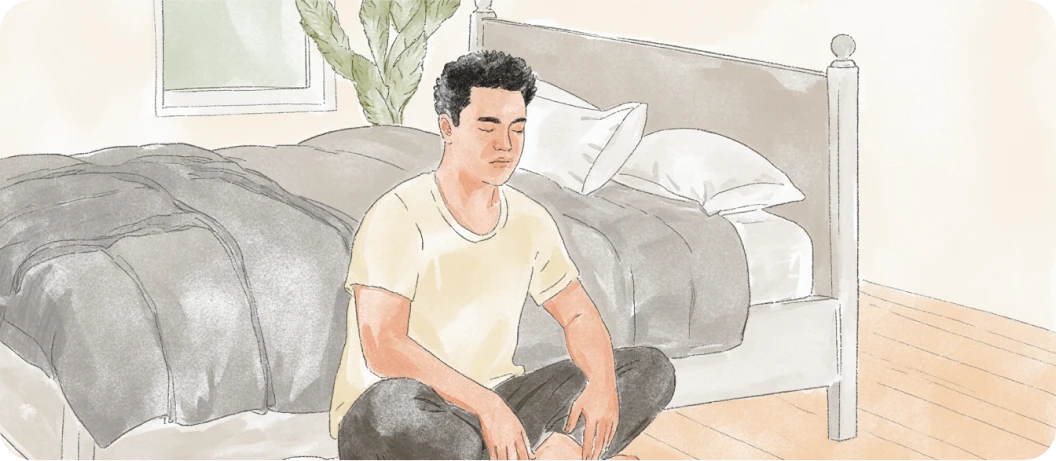Ever feel overwhelmed, anxious, or disconnected from your body as if you’re floating outside yourself? Do your stressful thoughts sometimes spiral until you lose touch with what’s real, here and now? What if you could press pause on mental chaos and return to reality? This can be done with the help of grounding techniques.
Grounding is a set of techniques that help you “anchor” to the present moment to cope with high stress. In addition to calming you down during strong feelings, grounding techniques are also helpful for people who experience panic attacks, post-traumatic stress disorder, and anxiety disorders, according to research on the effects of grounding [1].
Curious about how you’re really coping? Take a quick well-being test to better understand your emotional state and discover what might help you feel more grounded.
Anxiety Grounding Techniques
There are many different grounding techniques for improving distress tolerance and coping with anxious thoughts, including literally walking barefoot on the grass or sitting comfortably in a calm place with feet on the ground. Most of these practices involve mindfulness activities like concentrating on one’s breathing, light physical exercises, routine actions, or objects surrounding one.
It takes only a few minutes, and you can use it anytime and anywhere to feel more in control, focused, safe, and stay present. If you’re wondering how to calm down, we offer the most effective physical and mental grounding practices approved by our licensed mental health professionals. You will not need anything for it, just 3-5 free minutes.
7 Physical Grounding Techniques
These grounding exercises are coping strategies that can help you come out of a frozen or detached state so you can get out of your head, and calm your nervous system so you can think more clearly and choose your actions. As not every grounding technique works for everyone, feel free to skip or modify anything that feels uncomfortable.
1. Try sensory grounding practice
- Place both feet on the floor or ground. Stamp your feet a few times, shifting your weight from one foot to the other, or wiggle your toes, paying attention to the sensations in your toes, feet, and ankles.
- Press or rub your palms together, noticing the pressure, warmth, or coolness, and sensations as you touch them.
- Touch a small object within your reach. Notice its texture, temperature, and weight.
- Tap your fingers on your knees. Notice the sensations in both your fingers and knees, and the rhythm you are tapping. Try alternating left and right taps.
Tip
If you’re at home, take a shower or bath. Focus on each step of getting ready for it, noticing every little detail. How does your hand feel when you touch the door handle and the faucet? When you turn on the faucet, how do you know the right temperature of water? Notice how the water feels on your body, paying attention to the temperature and sounds of the water, and the sensations of your body muscles.
If you don’t have much time, you can just hold a piece of ice in your hand, noticing the sensation of cold and the feel of the water on your skin as the ice melts.
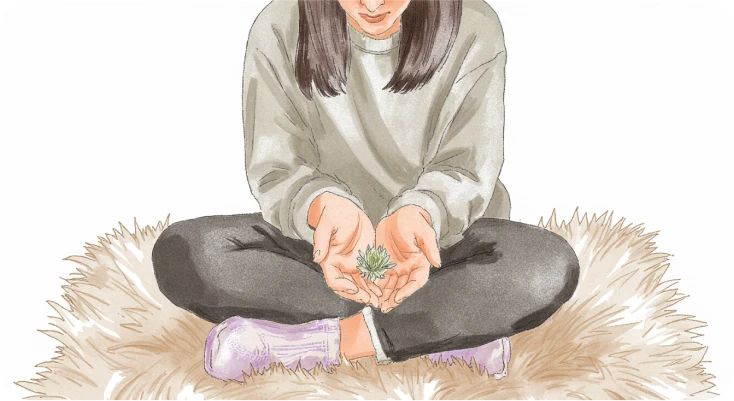
2. Use 5-4-3-2-1 anxiety grounding techniques
The next step is to switch your attention from anxious thoughts to what surrounds you. The 5-4-3-2-1 technique may help you distract yourself from distressing thoughts, understand how to clear your mind, and stop negative thought patterns, according to the University of Rochester Medical Center [2].
- Name five things that you see
It can be anything, like a wall or a phone lying in front of you. Notice the structure, color, and size of the object. For example, you see a glass vase in front of you. The vase is brown and smooth, and a white strip of light from the window falls on it. Describe all the details of the object you notice to yourself or out loud.
- Touch four objects
You can take any objects that are nearby, such as a glass of water. Touch its surface and notice whether it is smooth or rough, cold or warm. Then, switch your attention to the physical body. Feel how your feet touch the floor, how your clothes touch your body, and how your muscles feel. Try to relax the muscles that feel tense.
- Note three sounds that you are hearing right now
Pay attention to your surroundings and to things you can hear at the present moment. Maybe you hear birds singing, construction sounds, and an air conditioner. If you hear a conversation, try to listen to the timbre of the people’s voices, how loudly or quietly they speak.
- Notice two things you can smell
For example, the smell of your coworker’s perfume or the fresh bread from the nearest bakery, or the scent of shampoo on your hair. If you don’t smell anything, imagine the ones you like. For example, the smell of freshly brewed coffee, fresh strawberries, or your favorite flowers. Focus on this sensation.
- Taste one product
Try to eat mindfully, without being distracted, when you chew food. Alternatively, grab a piece of candy, a mint, a sip of water, or coffee.
Expert Insight
Grounding techniques help with anxiety and panic attacks by shifting focus away from overwhelming thoughts and bringing attention back to the present moment. During a panic attack, the body often goes into fight-or-flight mode, and grounding can signal to the nervous system that it’s safe to slow down. Sensory-based practices, such as feeling your feet on the floor or naming things around you, interrupt the cycle of fear and help anchor you in the here and now. This can reduce the intensity of physical symptoms like a racing heart, dizziness, or shortness of breath. Grounding also helps people feel more in control during a moment that often feels unpredictable or frightening. With regular use, these techniques can build emotional regulation skills and reduce the fear of future panic episodes.
Abigail Fernald
Mental health professional
3. Create a grounding kit
Another way to do this technique is to prepare objects that engage all your senses in advance and use them in stressful situations. Here’s what you can do:
- Prepare something you can see. For example, your childhood photo, a photo of a loved one, a family trip, or your pet.
- Prepare something you can touch. A soft blanket or cozy, warm scarf; anything can give you a tactile sensation you would like.
- Prepare something you can listen to. Soothing music you like.
- Prepare something you can smell. It can be an aroma candle or a diffuser.
- Prepare things you can taste. For example, herbal tea with gingerbread cookies, or another food or drink you like.
Tip
Find a grounding object that brings you a sense of calm or comfort. It could be something like a smooth stone, a polished piece of glass, a ball of yarn, or a keepsake that holds positive memories. Choose something easy to carry in your pocket, bag, or desk drawer.
When you feel overwhelmed or disconnected, take out your grounding object. Hold it in your hand and bring your full attention to it. Describe every detail of the object in your mind as you touch it, and notice all the sensations of that touch.
4. Focus on your breathing
Try to take deep breaths and consciously slow them down. Place your hand on your belly and feel it move with your breath. Exhale the air completely from your lungs, and then inhale it as slowly as possible. You can try inhaling through your nose and exhaling through your mouth. According to the recent study, breathing practices can positively influence the autonomic nervous system and calm brain activity, reducing stress [3].
If you sometimes think, “Why do I not feel like myself?”, try a guided breathing exercise with Breeze Mindful Breathing. It walks you through calming breathwork to reduce negative thoughts and improve your mental health.
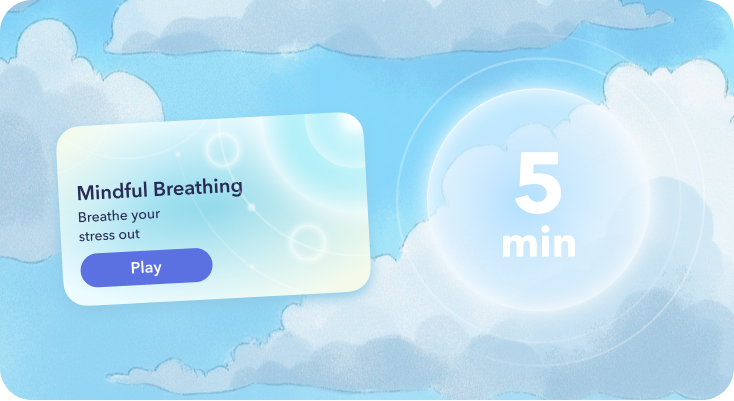
5. Progressive muscle relaxation
During this grounding technique, try to notice the difference in sensations between muscle tension and relaxation of the body muscles :
1. Inhale, then tense your fingers, spreading them as wide as possible. Do this for 5 seconds, then exhale and relax your fingers.
2. Relax for 10-20 seconds.
3. Clench your fists, then relax them.
4. Tense your forearms, then relax them.
5. Bring your shoulders together, then relax them.
6. Literally ground yourself
Lie down on the floor. Do a quick body scan to notice where exactly the floor touches it, what parts of your body feel it, and focus on that sensation of pressure, texture, and temperature. Notice any vibrations you can feel right now.
7. Go outside or observe your surroundings through the window
If you notice yourself feeling scattered or disconnected, that’s a natural response to overwhelm. Here’s a gentle exercise that might help you refocus.
For example, if you choose a tree, observe how the light falls on it and where the shadows from its branches land. Count how many branches it has, whether they have buds, flowers, or leaves. Look closely at the texture of the trunk. Are the branches straight or curved? What shape are the tree’s leaves? Let each detail pull you deeper into the present moment
4 Mental Grounding Techniques
Try the following mental techniques to learn how to live in the moment to reduce feelings of worry and anxiety associated with past or future events.
1. Recognize your thoughts
Pay attention to the thoughts and feelings that are overwhelming you. Note these thoughts to yourself or say them out loud. You can say them out loud or quietly name them to yourself: “I’m feeling anxious,” or “I’m thinking about something that upset me.” Do not judge the emotions and thoughts; just accept them as facts and try to feel your feelings instead of intellectualizing them.
Use Breeze Journaling to write down what’s on your mind. It helps you organize your thoughts, spot patterns, and create space between you and your emotions, so you can respond instead of react.
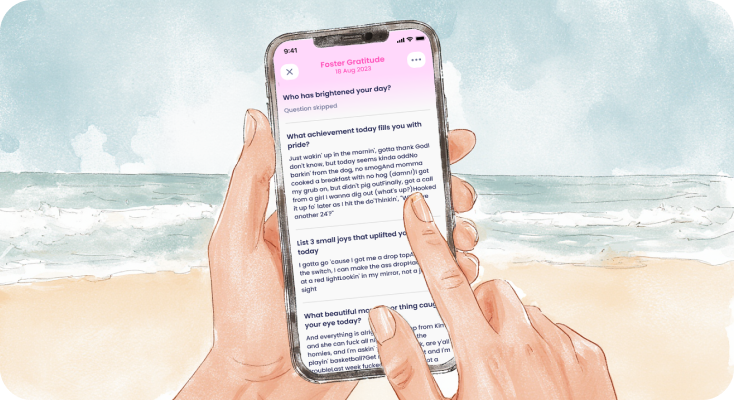
2. Use grounding affirmations
Studies using fMRI scans show that affirmations stimulate the part of the brain involved in self-reflection and processing personal relevance [4]. That means you’re literally reprogramming how you see and talk to yourself.
Repeat the safety statement to remind yourself that you are safe now. You can formulate the safety statement using the following structure:
“My name is _. I am safe now. I am in the present, not in the past or future. Today’s date is __. This is a new moment. I am supported and safe here and now.”
Keep a list of positive affirmations to read when you feel lost, anxious, or overwhelmed. Try to repeat them silently or aloud, feeling each word land in your body:
- “I am here now.”
- “This feeling is temporary.”
- “My thoughts are not facts.”
- “I can pause and find my center.”
- “One breath at a time.”
With Breeze Daily Affirmations, you can choose supportive personalized phrases that speak to your current state of mind and build a consistent practice to reframe your inner dialogue and improve self-trust.
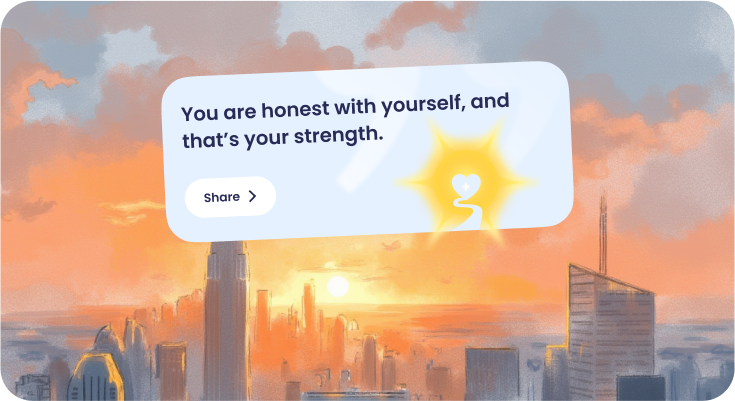
3. Read something from memory
Think of a poem, song, or passage from a book that you know by heart. Read it quietly or silently to yourself. If you are saying the words out loud, focus on the shape of each word on your lips and in your mouth. If you are saying the words in your mind, visualize each word as if you see it on the page.
4. Try positive visualization
If you are upset or sad, visualize someone you love. Picture their face or think about what their voice sounds like. Imagine them telling you that this is a tough time, but you can handle it.
Expert Insight
Grounding techniques are important for mental health because they help bring the mind and body back to the present moment, especially during periods of overwhelm, anxiety, or dissociation. When someone is caught in a loop of stressful thoughts or emotional distress, grounding offers a way to pause, reconnect with their senses, and regain a sense of control. These practices can regulate the nervous system, reduce symptoms of panic or dissociation, and create a feeling of safety in the body. Grounding also supports emotional resilience by helping people respond to distress with awareness rather than impulsivity.
Abigail Fernald
Mental health professional
Are You Looking for More Grounding Exercises and Quizzes for Your Mental Health?
If you want to get more tests, games, routines and grounding techniques, Breeze Wellbeing is what you’ve been looking for. The app helps you better understand your emotions, habits, and thought patterns so you can feel more grounded and improve your overall well-being with personalized treatment plans.
In just 10 minutes a day, you can:
- Track your mood and identify what truly influences how you feel to develop emotional regulation.
- Explore science-based tools, relaxation games, and different techniques to help you grow and become the best version of yourself.
- Build healthy habits and create personalized routines for your daily life without pressure or burnout.
- Take self-discovery tests about career, relationships, childhood trauma, emotional intelligence, and many more to gain insights into your personality and improve your health.
- Learn how to love yourself with guided exercises and daily affirmations for calm, focus, and emotional balance.
Sources
- Oschman JL, Chevalier G, Brown R. The effects of grounding (earthing) on inflammation, the immune response, wound healing, and prevention and treatment of chronic inflammatory and autoimmune diseases. March 2015.
- University of Rochester Medical Center. 5-4-3-2-1 coping technique for anxiety.
- Bentley TGK, D’Andrea-Penna G, Rakic M, Arce N, LaFaille M, Berman R, Cooley K, Sprimont P. “Breathing Practices for Stress and Anxiety Reduction: Conceptual Framework of Implementation Guidelines Based on a Systematic Review of the Published Literature. Brain Sci.” 2023
- National Library of Medicine. Self-affirmation activates brain systems associated with self-related processing and reward and is reinforced by future orientation. November 2015.
Disclaimer
This article is for general informative and self-discovery purposes only. It should not replace expert guidance from professionals.
Any action you take in response to the information in this article, whether directly or indirectly, is solely your responsibility and is done at your own risk. Breeze content team and its mental health experts disclaim any liability, loss, or risk, personal, professional, or otherwise, which may result from the use and/or application of any content.
Always consult your doctor or other certified health practitioner with any medical questions or concerns
Breeze articles exclusively cite trusted sources, such as academic research institutions and medical associations, including research and studies from PubMed, ResearchGate, or similar databases. Examine our subject-matter editors and editorial process to see how we verify facts and maintain the accuracy, reliability, and trustworthiness of our material.
Was this article helpful?
